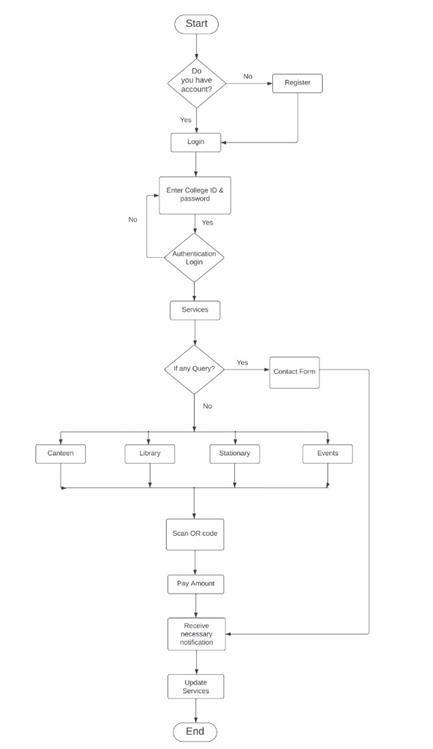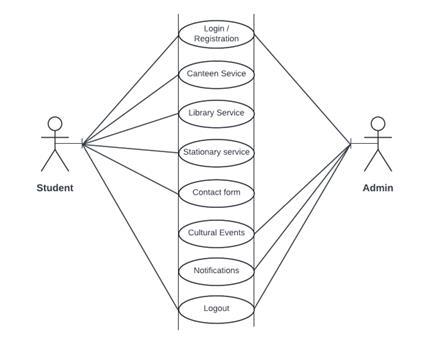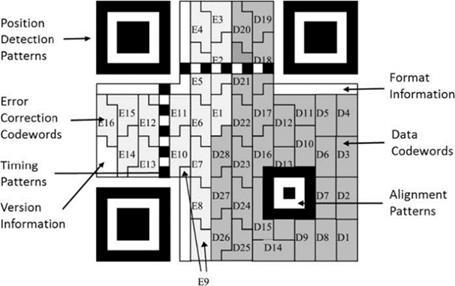
Volume: 11 Issue: 07 | July 2024 www.irjet.net p-ISSN: 2395-0072


Volume: 11 Issue: 07 | July 2024 www.irjet.net p-ISSN: 2395-0072
Yash
Katkar1 , Prathamesh Pillamari2 , Aniket Bhatkar3, Yash Malkar4 , Prof. Shrusti Jadhav5
1,2,3,4 Student, Dept. Of COMP Engineering, VPPCOE & VA, Maharashtra, India 5Professor, Dept. Of COMP Engineering, VPPCOE & VA, Maharashtra, India
Abstract - This project introduces an innovative approach to financial management within the college setting, presenting a unified and multifunctional application for cashless transactions. Through the utilization of smartphones, which are widely used by students, this application offers a centralized platform for accessing vital campus services and information. Its intuitive UI makes it easier to do things like issuing a book from library, and pay for things in the cafeteria and stationery store on campus. Furthermore, the application facilitates effective communication between administrators and students by offering functionalities such as transaction history, low balance alerts, and impending event notifications. In addition, the integration of QR code technology improves security, seamless and comfortable interactions. All things considered, this Android app offers a progressive approach to college administration that uses mobile technology to improve accessibility, effectiveness, and general satisfaction.
Key Words: QR Code Image Generation, QR Code Image Detection, Micropayment, Campus Services, Student Administrator Communication, Transaction History.
In today's digital age, the demand for efficient and secure paymentsystemswithineducationalinstitutionshasbecome increasinglyevident.Ourprojectaimstorevolutionizethe waystudentsmakepaymentsoncampusbyintroducinga comprehensive online platform. This platform will enable students to utilize a singular QR code for seamless transactions at various campus facilities, including the canteen,library,andstationarystores.
The primary objective of this project is to address the prevalentchallengesassociatedwithtraditionalcash-based transactions within educational settings. By leveraging modern technologyandinnovativepaymentsolutions, we strive to enhance the overall experience for students and administrativestaffalike,ensuringconvenience,speed,and accuracyinfinancialtransactions.
The project aims to create an Android app to enhance campuslifebyleveragingsmartphoneubiquity.Itprovidesa centralized platform for assessing campus services, streamliningprocesseslikecourseregistrationandlibrary access using intuitive design and QR code technology.
Additionally,theappfacilitatestransparentcommunication between student and administrators through real time notifications. Overall, it seeks to boost accessibility, efficiency, and satisfaction for both students and administrativestaff.
Themainobjectivesofthissystemare:
Simplify student life by offering a user-friendly mobileapplication.
Enhance accessibility to campus services like the canteen,library,andstationarystore.
Ensure secure and transparent financial transactionsusinguniqueQRcodes.
Enableeffectivecommunicationbetweenstudents andadministrators.
Empower administrators with comprehensive oversightcapabilities.
Promote student engagement through real-time notifications.
Utilizetechnologytooptimizecampusmanagement processes.
Foster a sense of community and collaboration amongstudentsandadministrators.
Traditionalpaymentmethodsoncampusesofteninvolvethe cumbersome handling of physical currency, leading to inconveniences such aslong queues, errors in accounting, anddifficultiesintrackingtransactions.Studentsfrequently encounter challenges in managing cash for daily expenditures as well as often face challenges in staying updatedwithimportantinformation,whileadministrative staffstrugglewithmanualrecord-keepingandreconciliation processes.Theseinefficienciesnotonlydisruptthesmooth functioningofcampusfacilitiesbutalsoimpacttheoverall productivityandsatisfactionofthecampuscommunity.
The lack of a unified, digital payment system exacerbates these issues, creating an urgent need for a solution that streamlines financial transactions within the campus International Research Journal of Engineering and Technology (IRJET) e-ISSN: 2395-0056

International Research Journal of Engineering and Technology (IRJET) e-ISSN: 2395-0056
Volume: 11 Issue: 07 | July 2024 www.irjet.net p-ISSN: 2395-0072
environment.Ourprojectseekstobridgethisgapbyoffering a secure, efficient, and user-friendly digital payment platform tailoredspecificallyto the needsofstudentsand campusserviceproviders.
Thegoal oftheplanneddigital paymentinfrastructurefor campusamenitiesistomaketransactionsacrossdifferent facilities likethecanteen,library,andstationarystores moreefficientbyusinguniqueQRcodesthatareprovidedto eachstudent.Tosecureloginandaccesstothesite,students begin their involvement by registering with basic information such as name, branch, year, and college ID. Students may easily access services like seeing cafeteria menus,perusingandcheckingout booksfrom thelibrary, andmakingpurchasesofstationerybyscanningQRcodes aftertheyhavecheckedin.Theportalalsoprovidesstudents with the ease of tracking borrowed books, monitoring transaction histories, checking balances, and contacting administratorsdirectlyusingaqueryoption.Administrators areprovidedwitheffectivetoolsbythesystemtomanage student data and transactions. They can provide students individualQRcodes,updateaccountswithmoniesreceived, andpromptlyremindstudentsabouttests.Additionally,the platform records every transaction, giving administrators valuableinformationonhowstudentsbehaveandhowthe facilitiesareused.To ensurethat the system canadapt to changingneedsoncampus,administratorscanalsoupdate information on book lists, stationary goods, and canteen menus. Essentially, this technology gives administrators completesupervisionandadministrativecapabilitieswhile alsomakingcampustransactionseasierforstudents.
5.1 Advantages of Proposed System
Streamlined registration and login process for students.
Convenient access to campus services like the canteen,library,andstationaryshop.
Cashless transactions using QR code scanning, enhancingsecurityandconvenience.
Timely notifications for borrowed library books, latepenalties,andlowbalances.
Easytrackingofremainingbalancesandtransaction historyforstudents.
Efficient management of student data and transactionsforadministrators.
5.2 Functional Requirement
UsersshouldbeabletologinusingtheircollegeID andpassword.
Provideasectionforuserstosendqueriestoadmin email.
Allowadminaccesstostudenthistoryanddetails sortedbybranchandyear.
Assign unique QR codes to students upon registration
Allowadmintoupdatecanteenmenu,booklist,and stationaryitemslist.
5.3 Non-functional Requirement
The system should be able to handle a growing number of users and transactions without significantdegradationinperformance.
Mobileappsshouldbeconnectedwiththeinternet.
5.4 Flow-Chart

Chart -1:Flowchart
5.5 Features
An advanced meal ordering system that saves the user time by allowing them to place their orders directlyfromtheapplication,eliminatingtheneedto gogetfood.

International Research Journal of Engineering and Technology (IRJET) e-ISSN: 2395-0056
Volume: 11 Issue: 07 | July 2024 www.irjet.net p-ISSN: 2395-0072
Withtheapp,studentscanquicklycheckhowmany books areissued in their names and conveniently issueabookfromthelibrary.
Theapplication'sinteractivefeaturesallowusersto receive notification about when the issued book needstobereturnedwithinacertainspanoftime.
Reducingtheamountofpaperusedbycreatingsoft copies of invoices that both vendors and students mayaccess.
There is no requirement to pay any fees because thereisnopaymentinterface.
Currently, the campus operates on traditional payment methods,predominantlyreliantoncashtransactionsatthe canteen,library,andstationarystores.Whilesomefacilities mightacceptcardpayments,theabsenceofaunifieddigital platform results in fragmented payment experiences for students. These systems lack synchronization, leading to inefficiencies in tracking expenditures and managing accounts.
Moreover,therelianceonphysicalcurrencyposessecurity risks and operational challenges, including the need for constantcashhandling,increasedpossibilitiesoferrors,and theinconvenienceofcarryingandmanagingcashforboth studentsandadministrativestaff.
Manualprocessesaretime-consumingandproneto errors.
Limited accessibility to campus services leads to inconvenienceforstudents.
Communication between students and administratorsisoftendelayedorinefficient.
Difficulty in tracking student activities such as librarybookreturnsorcanteentransactions.
Security risks associated with handling data manually.
Lackofreal-timeupdates.
Ourprojectfollowsacomprehensiveframeworkdesignedto ensurethedeliveryofahigh-qualitysoftwaresolutionthat enhancesthecampusexperienceforallusers.Westartby meticulouslygatheringandanalyzingrequirementsfromall stakeholdersthroughinterviews,surveys,andworkshopsto understand the needs and expectations of the end-users. Detailed documentation is created to capture these requirements,formingthefoundationfortheentireproject.
Usingthecollectedrequirements,wemoveintothedesign phase, creating initial prototypes and mockups. These designsarereviewedandrefinedthroughiterativecycles, incorporatingfeedbackfromstakeholdersateachstageto ensurealignmentwiththeirvisionandneeds.
Developmentiscarriedoutiniterativesprints,allowingfor incremental progressandregularassessment.Eachsprint focusesonimplementingaspecificsetoffeatures,whichare then reviewed and tested before moving on to the next iteration.OurtechstackincludesrobusttoolslikeMySQLfor data storage, ensuring efficient and secure data management, and Flask, a lightweight and flexible framework,isusedfordevelopingthebackend,particularly suitableforAndroidapplicationdevelopment.
Throughout the design, development, and testing phases, continuouscommunicationwithstakeholdersismaintained through regular meetings, updates, and demo sessions to gatherfeedbackandmakenecessaryadjustments,ensuring theprojectremainsontrackandmeetsuserexpectations. Rigoroustestingisanintegralpartofourprocess,including unit testing, integration testing, system testing, and user acceptancetesting(UAT).Testcasesaredesignedtocover all possible scenarios, ensuring the software is free from bugsandperformsreliablyundervariousconditions.
Oncethesoftwarepassesalltestingphases,itispreparedfor deployment. This involves setting up the production environment, configuring servers, and ensuring all dependencies are correctly managed. A rollout plan is created to ensure a smooth transition, minimizing any disruptiontousers.Afterdeployment,weprovideongoing supporttoaddressanyissuesthatmayariseandtoensure the software continues to function as intended. User feedback is continually monitored to make further improvementsandupdatesasneeded.
Our methodical approach, characterized by meticulous planning,continuousfeedback,thoroughtesting,andcareful deployment,aimstodeliverastableandreliablesoftware solution. The ultimate goal is to enhance the campus experience for all users, providing a seamless and userfriendly application that meets their needs effectively. By adheringtothisstructuredframework,weensurethatour projectnotonlymeetsbutexceedsexpectations,deliveringa high-quality,stable,anduser-centricsoftwaresolution.
8.
Android:
Androidprovidesarichapplicationframeworkthat allowsyoutobuildinnovativeappsandgamesfor mobile devices in a Java language environment. The documents listed in the left navigation provide details about how to buildappsusingAndroid'svariousAPIs.Androidappsare built as a combination of distinct components that can be

International Research Journal of Engineering and Technology (IRJET) e-ISSN: 2395-0056
Volume: 11 Issue: 07 | July 2024 www.irjet.net p-ISSN: 2395-0072
invoked individually. For instance, an individual activity providesasinglescreenforauserinterface,andaservice independentlyperformsworkinthebackground.
Python:
Python is a versatile, high-level programming language knownforitssimplicityandreadability.Itsupportsobjectoriented programming, dynamic typing, and dynamic binding,makingitidealforrapiddevelopmentandscripting tasks. With no compilation step, the development cycle is fast,anddebuggingisstraightforward becauseof built-in error handling and a source-level debugger. Python's extensive standard library, modularity, and code reuse capabilitiesfurtherenhanceitsappealtodevelopers.
Flask:
FlaskisalightweightwebapplicationframeworkforPython, designed for flexibility and speed. It simplifies web development by handling environment and project setup, allowingdeveloperstofocusontheirapplicationlogicrather thanlow-leveldetailslikeHTTPhandlingandrouting.While Flask lacks built-in features like database abstraction and form validation, it supports extensions for adding such functionalities. Originally created as a joke, Flask gained popularityduetoitssimplicityandextensibility,becoming oneofthemostpopularPythonwebframeworksalongside Django.
ThesearesomeImportantfeaturesoftheFlask:
ItisaDevelopmentServer.
Debugger.
RESTfulrequestdispatching.
UnicodeBased.
IthasgoogleappengineCompatibility.
8.1 Use Case Diagram

OursystemutilizesQRcodetechnologyforsecurestudent identificationandtransactionauthentication,ensuringquick andreliableaccesstoaccountswhileminimizingfraudrisk. Robust online payment gateways integrated with the campusfinancialinfrastructureguaranteeswiftandsecure transactions. User account management and encrypted databasesprotectsensitivedata,providingauser-friendly interface for students and efficient data management for administrators.Thisapproachaimstoestablishacohesive andreliabledigitalpaymentecosystemtailoredtocampus needs.
A QR code is a two-dimensional barcode that consists of black squares arranged on a white background. These squareboxesareknownasdetectionmarkersandplayakey roleinscanninganddecodingthecode.

Theprocessofdecodinga QR codestartswithscanning it usingaQRcodescanner.Uponscanning,thescannerdetects the alignment pattern, which helps in orienting the code correctly.Oncethescanneridentifiesthealignmentpattern, it proceeds to decode the data stored in the QR code. The datacanbeintheformofnumeric,alphanumeric,binary,or kanjicharacters.
One essential aspect of QR codes is their error correction capability.QRcodeshavebuilt-inerrorcorrectionkeysthat enablethescannertoaccesstheinformationevenifthecode is slightly damaged or missing some parts. With error correctionkeys,QRcodescanwithstandupto30%damage withoutcompromisingtheirfunctionality.
The concept of micropayments has gained significant prominence with the advent of digital technology and the proliferation of online content and digital goods and services. Micropayments refer to small financial transactions, typically ranging from a few cents to a few

Volume: 11 Issue: 07 | July 2024 www.irjet.net p-ISSN: 2395-0072
dollars,thatfallbelowthethresholdoftraditionalpayment systems.Thesesmalltransactionsareoftenimpracticalor toocostlytoprocessusingconventionalpaymentmethods duetohightransactionfeesandoverheadcosts.Toaddress thesechallenges,APIs(ApplicationProgrammingInterfaces) andmicropaymentplatformshaveemerged,providingthe necessary infrastructure to facilitate the integration of micropaymentsystemsintovariousapplications.Thesetools enable developers to seamlessly incorporate small transactions into their applications, making it easier for users to pay for digital content and services in small increments.Micropaymentsarecommonlyassociatedwith varioustypesofdigitalcontentandservices.Forinstance, many news websites and content creators use micropaymentstomonetizetheircontent,allowingusersto payasmallfeetoaccessindividualarticlesorspecificpieces of content, making it a flexible and cost-effective option. Music platforms can offer individual song downloads or streamingaccessthroughmicropayments,enablingusersto purchase single tracks or temporary streaming rights withoutcommitting toa full albumorsubscription.Inthe gaming industry, micropayments are widely used for purchasingin-gameitems,upgrades,andadditionalcontent, enhancingthegamingexperiencewithoutsignificantupfront costs. Many mobile apps utilize micropayments to offer premium features, ad-free experiences, or additional content,allowinguserstomakesmallpaymentstounlock specificfunctionalitiesoraccessexclusivecontentwithinthe app.Beyondmediaandentertainment,micropaymentsare alsousedforvariousdigitalgoodsandservices,suchasebooks, software plugins, and online courses, reducing the financial barrier to entry for consumers. The rise of micropaymentplatformshasbeeninstrumentalinenabling thesetransactions,handlingthecomplexitiesofprocessing smallpaymentsefficientlyandsecurely,ensuringthatboth usersandcontentprovidersbenefitfromtheconvenience andaccessibilityofmicropayments.Overall,theconceptof micropaymentshasrevolutionizedthewaydigitalcontent and services are monetized, offering a flexible and userfriendly alternative to traditional payment models. By allowing consumers to pay in small increments, micropaymentshavemadeiteasierforpeopletoaccessand enjoy a wide range of digital offerings, fostering a more dynamicandinclusivedigitaleconomy.
TheappallowsUserstoaccesscampusservicesand managetheiraccountsconveniently
Streamlined processes such as canteen payments andlibrarybookborrowingsavetimeandeffort.
Userscaneasilytracktheirtransactions,balances, andborroweditems,enhancingtransparency.
Usersreceivenotificationsforvariousactivitieslike book issuances, due dates, and low balances, ensuringtimelyaction.
The app facilitates communication between studentsandadministrators,allowingqueriestobe sentdirectlytoadminemail.
Administratorscanefficientlymanagestudentdata, transactions, and resources, enhancing administrativeoversight.
Ultimately,theprojectpresentsathoroughwaytooptimize university services and enhance the correspondence between students and faculty. The software increases the effectiveness and transparency of overseeing student activitiesbygivinguserseasyaccesstonecessary services like the canteen, library, and stationery store. Thanks to functionalities like prompt alerts and efficient account administration,learnersmayremaininformedandinvolved intheireducationalpursuits.Thisinitiativeshowcaseshow technologymayimprovetheentireexperienceofstudentsin educationalinstitutionsandoffersasolidplatformforfuture improvements.
[1] K. V. Thangam, T. S. Kumar, V. Yogesh, and S. Prabhu, “Android Application for College Management System (M-Insproplus),”Int.J.Mod.TrendsEng.Res.,vol.4,no. 2,pp.41–44,2017.
[2] M. N. Dedhia and D. V. C. Kotak, “ANDROID BASED CAMPUSSOLUTIONFORCOLLEGE,”Int.J.Comput.Sci. Mob.Comput.,vol.6,no.11,pp.12–17,2017.
[3] K. Datarkar, N. Hajare, N. Fulzele, S. Kawle, V. Suryavanshi,andD.Radke,“OnlineCollegeManagement System,”Int.J.Comput.Sci.Mob.Comput.,vol.5,no.4, pp.118–122,2016.
[4] P. G. Scholar and E. Engineering, “DEVELOPING AN ANDROIDAPPLICATIONFORCOLLEGEMANAGEMENT SYSTEM”
[5] Dr.BMenaka(2019),”CashlessEconomy”
[6] Dr. Venkateswararao Podile, P. Rajesh (2017), “Public PerceptiononCashlessTransactionsinIndia”
[7] Dr.OmprakashGusai(2017),“CashToCashlessEconomy IssuesAndChallenges”.
[8] Preeti Garg, Manvi Panchal (2016), “Study on IntroductionofCashlessEconomyinIndia2016:Benefits &Challenge’s”
[9] Dr.Chandrakala(2019),“AStudyOnCashlessEconomyIn INDIA”